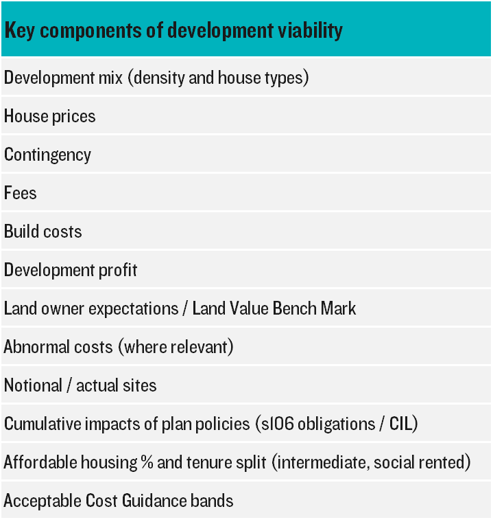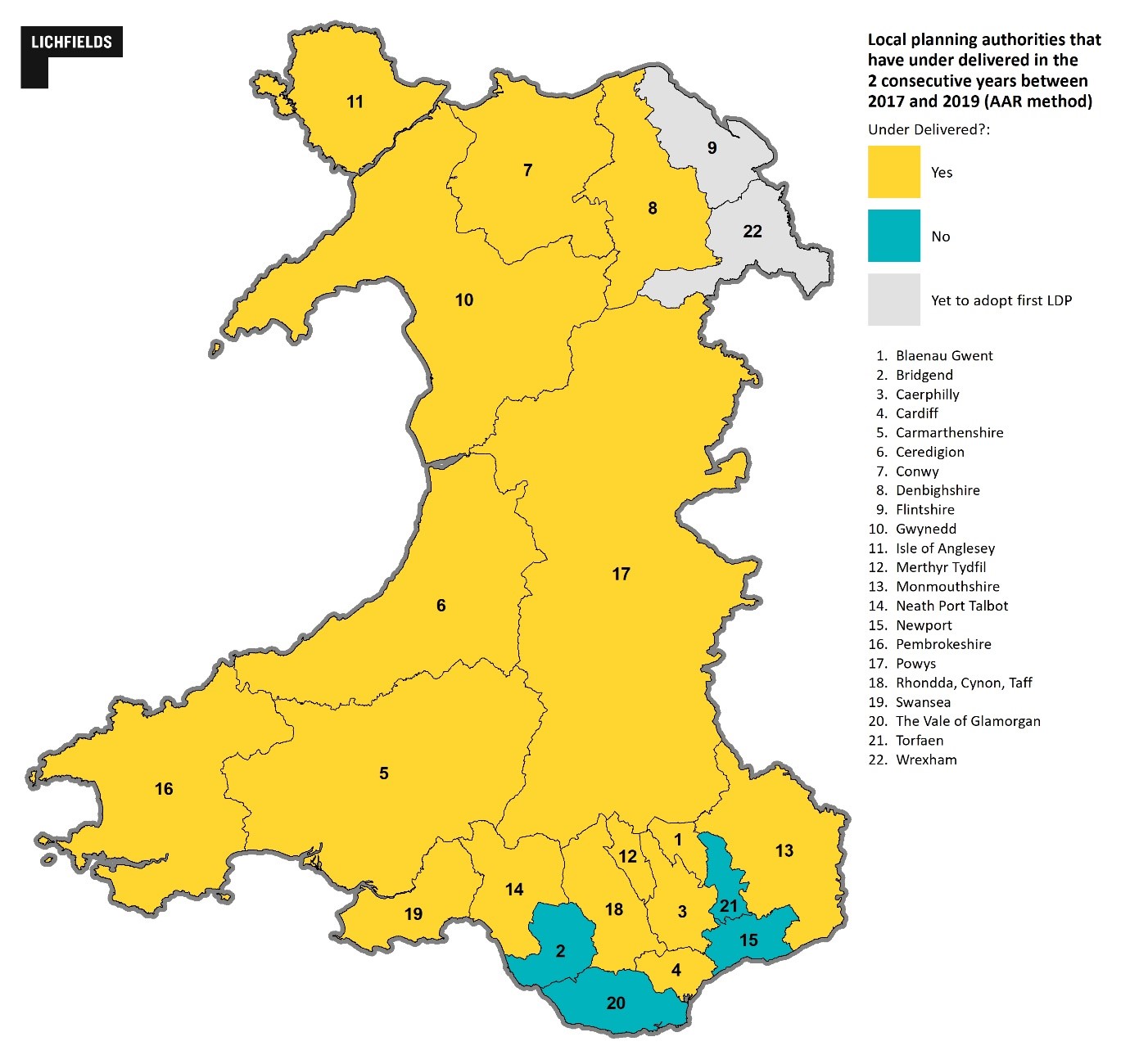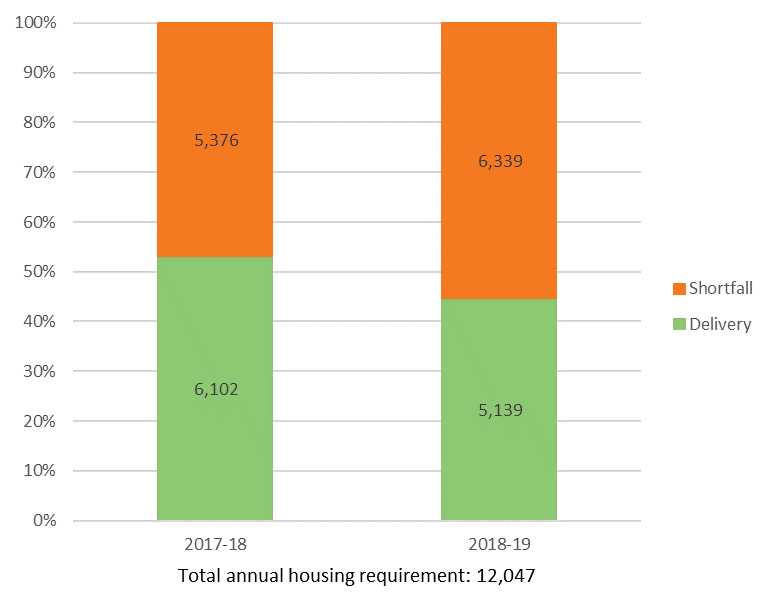The latest changes to the planning system enacted by the Welsh Government on 26 March 2020 follow the rationale that all new development should be identified through the plan-making process, with only limited scope for windfall sites. These changes include the revocation of Technical Advice Note 1 (TAN1) and the removal of the requirement for a five-year supply of housing land. Instead, local planning authorities (LPAs) will monitor housing delivery against LDP housing trajectories.
The new system is heavily reliant on the timely production of robust Local Development Plans (LDPs). In the context of the current COVID-19 crisis, this will be nigh on impossible to achieve. Full LDP reviews take at least four years to prepare, and delays are now inevitable, as Welsh local planning authorities (LPAs) are currently unable to fulfil the legal requirements for public consultation
[1]. This will have implications for the majority of LPAs in Wales, 17 of which
[2] have LDPs that are older than four years and so are currently subject to or due for review, whilst two have yet to adopt their first LDPs.
In these extraordinary times, there is an urgent need to think ahead and put measures in place to support an early economic recovery and to ensure much-needed housing can be delivered in the short term. Commentators are now stating the economic impact of COVID-19 will be severe and longer than originally anticipated, so there is a need to ensure that the development industry is supported to deliver quickly once the crisis is over. The construction of new homes (and other development) can play a key role in attracting investment and supporting jobs, and we simply cannot afford to wait years for the next round of LDPs to bring forward new development in Wales.
Hence, we are calling on the Welsh Government to take immediate steps to facilitate a swift economic recovery by providing support for development on sustainable sites in the short term outside of the plan-making process, which could be in the form of a policy clarification letter. These sites will need to comply with the sustainable development and place-making principles of Planning Policy Wales (PPW).
In this blog, we set out our initial comments on the changes, focused on the revisions to the Development Plans Manual (edition 3, March 2020, DPM). While this document represents guidance rather than policy, LPAs must have regard to it when preparing an LDP, as set out in the Planning and Compulsory Purchase Act 2004 (section 75).
A number of the changes to the DPM will help to support the adoption of robust plans – and so are welcome. However, key concerns remain in relation to the lack of specified consequences for under-delivery of housing – concerns which are heightened by the current crisis.
Setting the right housing requirement
It is positive that the revised DPM now recognises the importance of providing the right balance of homes and jobs. In particular, it acknowledges that there is a need to consider both housing and economic needs together when assessing growth and setting a long-term strategy, with the aim of reducing the need for commuting.
The DPM provides guidance as to how the need for homes and jobs should be assessed to inform requirements in LDPs. It states that the plan requirement should be based on the level of “unconstrained need” balanced against supply factors that limit the ability of the plan to deliver. For housing, it states that the unconstrained need should be calculated using evidence, which could include:
- The latest Welsh Government population and household projections – including a range of demographic scenarios;
- Housing Market and Local Need Assessments – setting out the need for different tenures and types of housing; and,
- Commuting patterns.
This unhindered need is then compared with supply factors that could affect delivery, such as physical or environmental capacity, land values and infrastructure costs, and policy-based considerations such as affordable housing targets.
While some of the need and supply factors seem to fall in the incorrect column (for example, “viability areas” and past build rates are cited as indications of need/demand), overall this approach is helpful as it distinguishes between the actual need for homes and jobs and the ability to deliver them in a particular location. Furthermore, it is encouraging to note that the DPM warns against simply rolling forward past build rates, recognising that they may have been constrained, for example, by economic factors.
Improving deliverability
Likewise, the changes to the DPM that increase the likelihood of allocated sites being deliverable are welcome.
Viability
The revised DPM takes forward the PPW focus on site-specific and plan-wide viability testing in order to support deliverability, and this is an
area of significant expertise for Lichfields. Although the updated DPM does not specify a set model for viability testing, it does identify what are considered to be the key components to development viability, as listed below and discussed in our
Components of Development Viability Summary Table.
Table 1: Key components of development viability identified by the DPM
Source: Development Plans Manual (3rd edition)
It goes on further to require that these specific components and their costs are discussed and agreed by a Viability Steering Group which will include key partners and consultees who consider and agree the specific costs that affect development viability in the local area. These agreed costs should then be embedded into the viability modelling which will inform the policies and allocations within the plan.
Rolling sites forward
The revised DPM includes strong guidance relating to allocations forming part of a previous plan. It states that these allocations should only be “rolled forward” where it has been evidenced there has been a “substantial change in circumstances” which enables the site to be delivered and so justifies its inclusion. Ensuring that sites that have not been delivered to date and that are considered to be non-deliverable are not rolled forward will help to boost housing delivery and strengthen the plan-led system.
Flexibility allowance
Although the changes already set out will promote the allocation of more deliverable sites, the DPM recognises that it will be “extremely rare” for all of the sites within a plan to be developed within the anticipated timescales. The DPM therefore appropriately requires that flexibility is embedded within the plan to account for non-delivery and unforeseen issues. The recommended starting position for the flexibility allowance is 10% but this figure should reflect local circumstances.
Non-delivery allowance for land bank commitments
The DPM states that LPAs with a large number of sites with extant planning permission should apply a non-delivery allowance to this element of the housing supply. This allowance, which is separate and in addition to the overall flexibility allowance above, should be based on local evidence. As a guide, the DPM states that non-delivery rates in these circumstances have ranged from 20 to 50%. This requirement is welcomed as another measure to ensure provision is made for sufficient levels of housing over a plan period.
Setting a robust housing trajectory
The heightened role of LDP housing trajectories in the new system means that it is essential that they are robust and that they reflect the overall timing of development, from initial pre-application discussions through to on-site phasing. As such, careful consideration of the timing of site delivery and all of the relevant factors associated with build rates is crucial to ensuring that the housing trajectory is robust.
Lichfields’ Start to Finish (2nd edition) research on the factors affecting build-out rates for large-scale housing sites provides a useful benchmark.
As recognised within the DPM, there is a need to collaborate with key stakeholders in the preparation of housing trajectories. The involvement of the private sector and developers in particular will be crucial in order to ensure trajectories are robust and deliverable. As noted by the DPM, it is also important that the trajectory provides a steady flow of sites throughout the plan period.
Monitoring and consequences
Under the new arrangements, LPAs will measure housing delivery against an estimated Average Annual Build Rate (AABR) for each individual year of the plan period as set out within the LDP housing trajectory. Hence, it is a forward-looking measure. The AABR should factor in phasing and delivery assumptions relating to individual sites, as described above. Housing trajectories are set to be updated each year as part of the AMR process; however, the AMR will not affect the AABR, which is based on the original trajectory in the adopted plan.
Interim measures
LPAs with an LDP adopted prior to the publication of the revised DPM and those that are currently under examination should use their Average Annual Requirement (AAR) as their primary monitoring indicator against which to measure levels of delivery. The AAR is simply the total housing requirement for the LDP period divided by the number of years in the plan period (15 years). However, these LPAs should begin preparing AABR-type trajectories in their AMRs.
Based on the AAR method, we note that a total of 17 of the 20 LPAs in Wales with an adopted LDP under delivered in the two consecutive years between 2017 and 2019 (see figure 1), and we note that all of the 20 LPAs under delivered in at least one of these years.
Figure 1: Local planning authorities that have under delivered for 2 consecutive years (2017-2019)
Source: Lichfields analysis of LDP housing requirements and Welsh Government New house building data
This measure indicates a cumulative shortfall of almost 12,000 homes between 2017 and 2019 (a 51% shortfall) (see figure 2). Hence, there is a clear need for action to fill these gaps across Wales.
Figure 2: Delivery against housing requirements for LPAs with adopted LDPs (AAR method) (2017-18 and 2019)
Source: Lichfields analysis of LDP housing requirements and Welsh Government New house building data
Consequences for under delivery
LPAs are required to consider performance against all indicators collectively and to assess the magnitude of variance before deciding on appropriate actions to be taken. The DPM specifies that trigger points that relate to housing completions should relate to performance over two consecutive years. Hence, under delivery in a single year would not be sufficient to trigger an action.
The DPM does not prescribe consequences for under delivery against the trajectory and, hence, there is no mechanism to ensure that new sites can come forward in the short term to fill gaps in supply. It is for each LPA to decide on its own remedial actions.
Implications
In order to function properly, the new system requires up-to-date LDPs that take forward the new standards in relation to housing requirements, deliverable allocations and the formulation of robust housing trajectories. However, plan preparation is an inherently slow process, and the current crisis means that delays are now inevitable. Hence, as things stand, there is no readily available avenue for new housing sites to come forward. This is a problem not just in terms of meeting the housing needs of people in Wales but it also represents a neglected opportunity to fuel up the economy while we await the starting flag of recovery.
We therefore recommend that the Welsh Government acts quickly to issue a policy clarification letter setting out that housing proposals that accord with the sustainable development principles of PPW should be supported in advance of the adoption of the next round of LDPs. It is also in the gift of LPAs to provide support for sustainable housing schemes in their areas by working proactively with developers. Both of these steps will be vital in order to support the Welsh economy after the Covid-19 crisis is over – which we hope will be very soon.
[1] The Welsh Government acknowledged this in its letter of 18 March 2020 to Chief Planning Officers , noting in particular that Monmouthshire, Torfaen and Ceredigion Councils would be unable to proceed with current or imminent LDP Preferred Strategy consultations. It also notes that, for those LPAs at the start of the LDP preparation process, this “may need to be postponed for several months”.[2] 17 of the 25 LPAs in Wales, including National Parks






